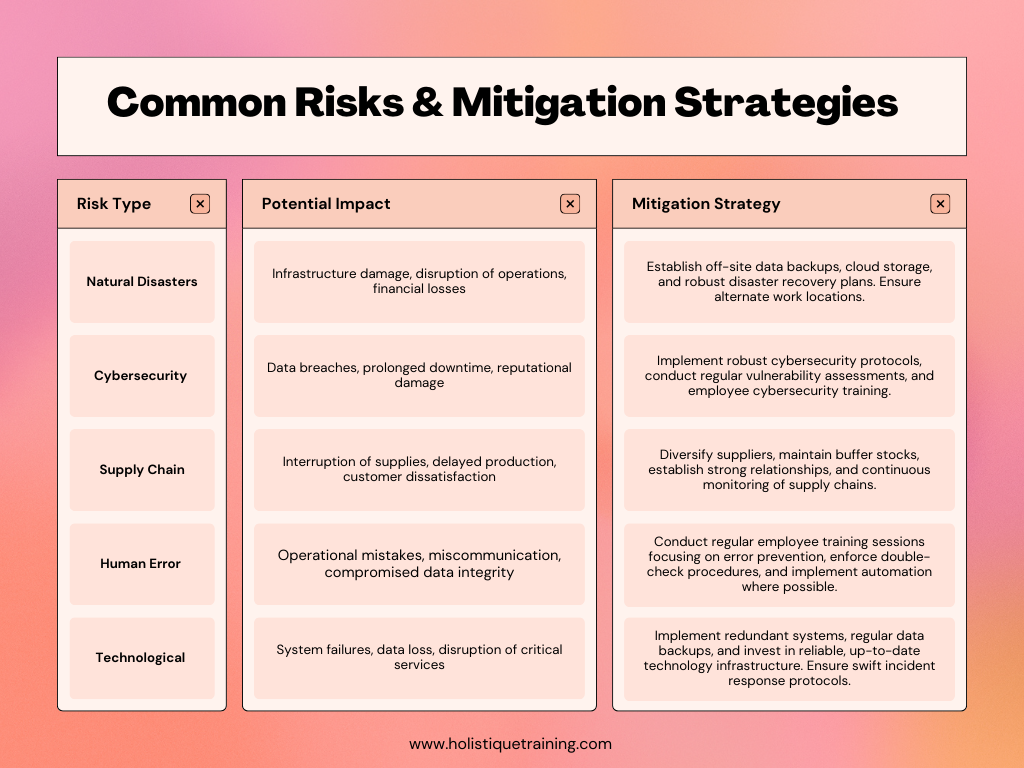The Goal of Business Continuity Planning
What Is Business Continuity Management?
The Business Continuity Management Lifecycle
Why Is Business Continuity Planning Important?
Key Components of a Business Continuity Plan
Pain Points to Address in a Business Continuity Plan
Factors to Consider When Developing a BCP
Who Should Work on and Approve the BCP?
Introduction
In a world characterised by constant change, businesses must adopt a proactive approach to secure their future. This is where Business Continuity Planning (BCP) comes into play. BCP is not merely an option but a strategic imperative for any organisation aiming to weather the storms that may disrupt their operations. In this comprehensive guide, we will delve deep into the realm of Business Continuity Planning, addressing its core concepts, components, importance, and the intricate processes that drive it.
The Goal of Business Continuity Planning
At its core, Business Continuity Planning is all about ensuring an organisation's ability to operate even in the face of adversity. The primary goal is to mitigate risks and ensure a swift recovery from any disruption, be it a natural disaster, a cyberattack, or a global pandemic. By doing so, a company can protect its reputation, maintain customer trust, and reduce financial losses, ultimately leading to a more secure and resilient future.
What Is Business Continuity Management?
Business Continuity Management (BCM) is the holistic approach an organisation takes to develop and maintain its BCP. It encompasses the strategic planning, risk assessment, and implementation of policies, procedures, and processes necessary to ensure business continuity. BCM recognises that business disruptions can take many forms, and its goal is to create a framework that addresses all potential scenarios.
The Business Continuity Management Lifecycle
The BCM lifecycle is a systematic approach that guides the development, implementation, and maintenance of a BCP. It consists of several interrelated phases:
1. Business Impact Analysis (BIA)
At the heart of the BCM lifecycle lies the Business Impact Analysis (BIA). This phase involves a meticulous examination of an organisation's functions, processes, and dependencies. By identifying critical operations, their interconnections, and potential vulnerabilities, businesses gain invaluable insights. The BIA essentially serves as a diagnostic tool, enabling organisations to discern the financial, operational, and reputational repercussions of a disruption. It's not merely about understanding what the organisation does, but rather comprehending how it does it and the implications if certain functions were to falter.
2. Risk Assessment and Analysis
The Risk Assessment and Analysis phase shines a spotlight on the lurking shadows of uncertainty. It involves identifying a spectrum of potential threats, from natural disasters to cybersecurity breaches, and evaluating their probability and impact. This analytical process empowers organisations to make informed decisions regarding risk mitigation. Through this phase, vulnerabilities are pinpointed, and risk scenarios are meticulously crafted, laying the foundation for the subsequent stages of the life cycle.
3. Strategy Development
Armed with insights from the BIA and Risk Assessment, organisations move into the Strategy Development phase. Here, strategies are crafted to enhance resilience. This involves devising plans to mitigate risks, ensuring continuity of critical operations, and establishing clear protocols for crisis management. The strategies may encompass a spectrum of initiatives, ranging from implementing redundant systems and data backups to formulating crisis communication plans. Each strategy is tailored to address specific risks identified during the earlier phases.
4. Plan Development and Testing
The Plan Development and Testing phase transforms theoretical strategies into actionable blueprints. Detailed BCP documents are created, outlining precise steps to be taken during a disruption. But a plan, no matter how well-crafted, is only as good as its execution. Hence, rigorous testing is imperative. Regular drills, simulations, and scenario-based exercises are conducted to assess the plan's efficacy. These tests not only identify potential weaknesses but also familiarise employees with their roles, ensuring a coordinated response during real-time crises.
5. Implementation and Maintenance
Implementation marks the moment of truth. The BCP is rolled out across the organisation, embedding resilience into the organisational culture. But resilience is not static; it evolves in tandem with the organisation and the external landscape. Therefore, the Maintenance phase is perpetual. Regular reviews, updates, and revisions are conducted to adapt the BCP to changing risks, technologies, and operational dynamics. Continuous training and awareness programmes ensure that employees remain vigilant and prepared, fostering a culture of readiness.
In essence, the Business Continuity Management Lifecycle is a beacon of resilience, illuminating the path for organisations to navigate the uncertainties of tomorrow. Embracing this lifecycle is not just a strategic choice; it's a commitment to safeguarding the very foundation upon which businesses thrive: continuity, adaptability, and unwavering resilience.
Why Is Business Continuity Planning Important?
In the tapestry of modern business, the thread of continuity is woven from careful planning, strategic foresight, and adaptability. Business Continuity Planning (BCP) isn't merely a document stored in a drawer; it's a dynamic process that underpins an organisation's ability to navigate tumultuous waters with grace and resilience. However, not all organisations realise its benefits, as nearly half of all companies lack a Business Continuity Plan, with 43% operating without this essential strategic framework, according to ZipDo. But why is Business Continuity Planning so vital? Let's unravel the intricacies of its importance:
Minimising Downtime
Time is the currency of business, and downtime is the thief that steals it away. Every moment of operational standstill equates to potential revenue loss, eroding profits and threatening sustainability. BCP serves as a shield against this threat, ensuring that essential functions continue uninterrupted, even amid a crisis. By minimising downtime, businesses retain their operational momentum, maintaining their competitive edge in the market.
Protecting Reputation
In the digital age, reputation is paramount. A single misstep during a crisis can tarnish the image carefully built over years. BCP safeguards an organisation’s reputation by ensuring transparency, swift response, and consistent service delivery, even in the face of adversity. By demonstrating resilience, businesses inspire trust among customers, partners, and stakeholders, solidifying relationships that form the bedrock of their success.
Regulatory Compliance
The regulatory landscape governing businesses is increasingly complex. Industries are bound by a web of laws and standards, mandating the implementation of robust BCP. Compliance isn't merely a checkbox; it's a legal obligation. BCP ensures that businesses adhere to these regulations, shielding them from legal repercussions while fostering a culture of responsibility and accountability.
Risk Mitigation
Every business faces a myriad of risks, from natural disasters to cyber threats. In fact, research shows that more than half of businesses, specifically 51%, faced with a major natural disaster, find themselves closing their doors within two years. Additionally, a staggering 75% of small businesses lack a Disaster Recovery Plan, leaving them vulnerable to severe disruptions. BCP is akin to a risk mitigation toolkit, enabling organisations to identify, assess, and mitigate these risks. By understanding vulnerabilities and formulating proactive strategies, businesses can transform potential threats into opportunities for growth. BCP is, in essence, the art of transforming adversity into advantage.
Customer Confidence
Customer confidence is the bedrock upon which successful businesses are built. When clients trust an organisation's ability to weather storms, they are more likely to remain loyal. BCP is a testament to an organisation's commitment to its customers' needs and concerns. By ensuring service continuity and transparent communication, businesses foster loyalty and create lasting impressions, nurturing relationships that endure even in challenging times.
In a world where change is the only constant, Business Continuity Planning isn't an option; it's a necessity. It's the difference between succumbing to the storm and emerging stronger on the other side. It's the assurance that no matter what challenges arise, businesses are not just prepared; they are fortified. BCP is the assurance that in the face of uncertainty, businesses don't just survive; they thrive, resilient and unwavering in their pursuit of success.
Key Components of a Business Continuity Plan
A well-structured Business Continuity Plan includes several essential components:
1. Executive Summary
At the outset of the BCP, an Executive Summary provides a strategic overview. It outlines the plan's purpose, objectives, and scope. This succinct section serves as a quick reference for top-level management, offering a snapshot of the organisation's preparedness strategy.
2. Business Impact Analysis (BIA)
The Business Impact Analysis (BIA) is the cornerstone of any BCP. It involves a meticulous assessment of the organisation's functions, processes, and dependencies. By identifying critical business functions, their dependencies, and the potential impact of their disruption, BIA forms the basis for the entire plan. It answers the fundamental question: What aspects of the business are absolutely essential for its survival and must be prioritised during a crisis?
3. Risk Assessment and Mitigation Strategies
This section outlines the results of a thorough risk assessment. It identifies potential risks, assesses their impact and likelihood, and proposes mitigation strategies. Risks can range from natural disasters to cyber threats and supply chain disruptions. Each identified risk is accompanied by a detailed mitigation plan, outlining steps to minimise the impact and likelihood of occurrence.
4. Crisis Management Procedures
In the face of a crisis, a coordinated response is essential. This section delineates the procedures and protocols to be followed during a crisis. It includes an incident response plan, communication strategies, and steps for activating the BCP. Clear roles and responsibilities are defined for key personnel, ensuring a swift and organised response that minimises confusion and maximises efficiency.
5. IT Recovery Plans
Given the digital nature of modern businesses, IT recovery plans are integral. This component outlines strategies for recovering IT systems, data, and networks in the event of a disruption. It includes backup and restoration procedures, cybersecurity measures, and IT infrastructure recovery strategies. IT recovery plans ensure the organisation's digital assets are protected and can be quickly restored, minimising downtime.
6. Employee Training and Awareness
Even the most meticulously crafted plan is ineffective without knowledgeable and prepared employees. This component focuses on training programmes, workshops, and awareness campaigns. Employees are educated about their roles and responsibilities during a crisis. Regular drills and simulations ensure that everyone understands the BCP and can execute their duties effectively, fostering a culture of readiness.
7. Plan Testing and Maintenance
A BCP is only valuable if it works in practice. Regular testing and maintenance are imperative. This section outlines the methods and frequency of plan testing, such as tabletop exercises, simulations, and real-time drills. Feedback from tests is used to refine the plan, ensuring it remains current and effective. Additionally, the plan is periodically reviewed to incorporate changes in the organisational structure, technologies, and external threats.
In an era where uncertainties are the norm and disruptions are inevitable, a comprehensive Business Continuity Plan is not just a strategic asset; it's a lifeline. It's the assurance that amidst the chaos, there's a method, a plan, and a pathway to not only endure but emerge stronger. With these key components in place, organisations don't just weather the storm; they navigate it with confidence, agility, and unwavering resilience.
Pain Points to Address in a Business Continuity Plan
In the intricate art of Business Continuity Planning (BCP), addressing potential pain points is akin to fortifying a castle before the storm. Every business faces unique challenges, and a well-crafted BCP is one that anticipates and mitigates these pain points effectively. Let's delve into the nuanced landscape of BCP and explore the specific pain points that organisations must address with foresight and strategic planning:
a. Resource Allocation
One of the fundamental challenges in crisis situations is resource scarcity. Whether it's manpower, equipment, or financial resources, allocation becomes a critical pain point. A robust BCP meticulously outlines resource allocation strategies, ensuring that essential resources are optimally distributed to critical functions. By preemptively addressing this challenge, businesses can avoid chaotic resource shortages during crises, allowing operations to continue with minimal disruptions.
b. Communication Breakdowns
Effective communication is the lifeblood of crisis management. Yet, communication breakdowns are common pain points during disruptions. A BCP must establish clear communication protocols, delineating channels, methods, and frequency of communication. It should include procedures for internal communication among employees as well as external communication with clients, stakeholders, and the public. By addressing communication challenges, businesses can maintain transparency, manage expectations, and foster trust even in turbulent times.
c. Data Security
Data breaches and loss pose significant threats during crises. Protecting sensitive information is a paramount concern. A BCP incorporates robust data security measures, including encrypted backups, secure access controls, and cybersecurity protocols. Addressing data security pain points ensures the integrity and confidentiality of critical information, safeguarding the organisation's reputation and compliance with data protection regulations.
Supply Chain Disruptions
Global businesses rely on intricate supply chains, making disruptions in the supply network a potent pain point. A comprehensive BCP assesses supply chain vulnerabilities and establishes alternative sourcing options. By diversifying suppliers, maintaining buffer inventories, and fostering relationships with reliable partners, organisations can mitigate the impact of supply chain disruptions. This proactive approach ensures the continuity of essential raw materials and components, preventing production bottlenecks.
Regulatory Compliance
Adherence to regulations is a non-negotiable aspect of business operations. Regulatory changes and compliance complexities often pose challenges during crises. A BCP includes a component dedicated to compliance, ensuring that the plan aligns with industry-specific regulations and standards. Regular audits and updates are essential to address evolving legal requirements, minimising legal risks and ensuring the organisation's continued operation within the bounds of the law.
A meticulously crafted BCP doesn't just offer a roadmap during disruptions; it empowers businesses to emerge stronger on the other side. It instals confidence in employees, fosters trust among stakeholders, and positions the organisation as a beacon of resilience in the face of adversity. With a forward-thinking approach to pain points, businesses can not only weather the storm but also harness it as a catalyst for innovation, adaptation, and enduring success.
Factors to Consider When Developing a BCP
Developing a robust Business Continuity Plan (BCP) is not merely a task; it's a strategic endeavour that demands careful consideration of a multitude of factors. In the ever-changing landscape of business, where uncertainties are as commonplace as opportunities, crafting a BCP involves foresight, adaptability, and a deep understanding of the organisation's intricacies. Here are the essential factors that organisations must consider when developing a BCP, ensuring that it becomes more than just a document but a blueprint for resilience:
1. Organisational Culture
The organisational culture forms the bedrock upon which a BCP stands. Consider the existing culture within the organisation – is it proactive or reactive? Is there a culture of accountability and continuous improvement? A BCP must align with the existing culture while also influencing it positively. Fostering a culture of preparedness, where employees value resilience and are proactive in safeguarding critical operations, is essential. This cultural alignment ensures that the BCP becomes ingrained in the organisation’s DNA, driving collective efforts toward resilience.
2. Budget Allocation
Developing and maintaining an effective BCP requires financial resources. Adequate budget allocation is essential to conduct risk assessments, implement necessary technologies, train employees, and conduct regular testing. While it might be tempting to cut corners, investing in business continuity is an investment in the organisation’s future stability. Proper funding ensures that the BCP is comprehensive, up-to-date, and capable of withstanding various challenges.
3. Employee Training
A BCP is only as effective as the people implementing it. Training employees in crisis response procedures, their roles during disruptions, and the importance of the BCP is paramount. Regular training sessions and drills not only empower employees but also build confidence and competence. Well-trained staff can make the difference between chaos and order during a crisis. Addressing this factor ensures that every member of the organisation becomes a guardian of resilience.
4. Scalability
Organisations are dynamic entities, evolving with time. A BCP must be scalable to accommodate growth and changes within the organisation. Consider how the plan can adapt to new products, services, or locations. Scalability ensures that the BCP remains relevant and effective even as the organisation expands. By anticipating growth-related challenges and integrating them into the plan, businesses can ensure seamless continuity irrespective of their scale.
5. Technology Integration
In the digital age, technology plays a pivotal role in business continuity. Integration of advanced technologies such as cloud-based solutions, real-time communication platforms, and data analytics enhances the BCP's effectiveness. Recent statistics reveal a significant shift, with 84% of businesses opting to store their data and backups in the cloud, indicating a growing trend towards digital resilience strategies. In addition to cloud-based solutions, automation can also streamline processes, ensuring rapid responses during crises. However, technology integration should also account for cybersecurity measures to protect digital assets from potential threats. By harnessing digital solutions while safeguarding them, organisations can bolster their resilience in the face of digital disruptions.
Table 2: Technology integration best practices
6. Stakeholder Engagement
A BCP doesn't operate in isolation; it's deeply intertwined with external stakeholders, including suppliers, partners, and customers. Engage with these stakeholders to understand their BCPs and collaboratively address potential interdependencies. Establish clear communication channels and protocols to coordinate efforts during joint crises. This collaborative approach fosters a network of support, ensuring a unified response to disruptions that affect multiple parties.
In the grand tapestry of business resilience, these factors are not just threads; they are the vibrant hues that bring the BCP to life. Embracing continuity as a strategic mindset ensures that an organisation doesn’t just endure disruptions but emerges from them stronger and more agile. By carefully considering these factors, businesses transform the BCP from a mere document into a dynamic, adaptable strategy that stands resilient against the tests of time and turmoil.
Who Should Work on and Approve the BCP?
The development and approval of a Business Continuity Plan involve multiple stakeholders within an organisation:
1. Executive Leadership
At the helm of the BCP process are the executive leaders – the visionaries and decision-makers. Their involvement is pivotal, as they provide strategic direction and set the tone for the entire organisation. The CEO, CFO, and other top-level executives play a crucial role in endorsing the BCP, ensuring it aligns with the organisation’s overall goals and objectives. Their approval signifies organisational commitment, providing the necessary impetus for the entire process.
2. BCP Team
The BCP Team comprises individuals with diverse expertise from various departments within the organisation. This multidisciplinary team includes representatives from IT, operations, human resources, legal, communication, and risk management. These experts collaborate to analyse risks, identify critical functions, and develop mitigation strategies. Their collective knowledge ensures that the BCP is comprehensive and well-rounded, addressing various facets of the organisation’s operations.
3. Legal and Compliance Experts
Legal and compliance experts play a pivotal role in ensuring that the BCP complies with industry-specific regulations, standards, and legal requirements. They provide insights into legal implications and help in aligning the plan with regulatory frameworks. Their involvement is crucial for avoiding legal pitfalls and ensuring that the BCP is not only effective but also compliant with the law.
4. IT and Security Personnel
In the digital age, IT and security personnel are the guardians of digital resilience. Their expertise is vital in crafting IT recovery plans, ensuring data security, and protecting digital assets during crises. IT professionals assess technological vulnerabilities and devise strategies for securing critical data and systems. Their insights are indispensable for creating a robust BCP in the face of cyber threats and digital disruptions.
5. Human Resources
Human Resources (HR) professionals are instrumental in training and empowering employees. They ensure that staff members understand their roles and responsibilities during crises. HR conducts training sessions, drills, and awareness programmes, fostering a culture of readiness among employees. Their involvement is pivotal in transforming the workforce into a proactive and knowledgeable line of defence during disruptions.
6. External Consultants
In complex industries or for organisations with unique challenges, external consultants specialising in business continuity and disaster recovery can provide valuable insights. These experts bring specialised knowledge and best practices, offering a fresh perspective on potential risks and mitigation strategies. Their input enhances the BCP’s depth and ensures that it encompasses the latest industry standards and innovations.
By involving executive leadership for strategic guidance, assembling a dedicated BCP team, consulting legal and compliance experts, engaging IT and security personnel, empowering employees through HR, and seeking external expertise where necessary, organisations can create a BCP that is not only robust but also adaptable. This collaborative approach ensures that the organisation is not just prepared for disruptions but is resilient, agile, and capable of thriving amidst challenges. In the realm of business continuity, the approval of the BCP becomes more than a formality; it becomes a testament to the organisation’s collective commitment to enduring and emerging stronger from any storm.
In Conclusion
Business Continuity Planning is an integral part of an organisation's strategy to ensure its resilience in the face of unforeseen disruptions. By defining its goals, managing the process through the BCM lifecycle, and addressing key components, pain points, and critical factors, an organisation can create an effective BCP. Involving a cross-functional team and obtaining executive approval are vital steps to ensure the plan's success. Ultimately, a well-executed BCP is not just a document but a shield that protects an organisation from the storms of uncertainty and ensures its longevity in an ever-changing world.
Ready to dive deeper into the world of risk management? Elevate your skills with our immersive course, ‘Business Risk Management Essentials & Strategies,’ where you'll learn to master the intricacies of resilience and turn challenges into triumphs. Enrol now and fortify your organisation's journey towards enduring success!
Frequently Asked Questions(FAQ)
What is Business Continuity Planning (BCP)?
BCP is a strategic approach that organisations use to ensure essential functions continue during and after a disaster. It includes risk assessments, crisis management protocols, and IT recovery strategies.
Why is BCP crucial for businesses?
BCP minimises downtime, protects reputation, ensures regulatory compliance, and mitigates risks. It fosters a culture of preparedness and empowers businesses to navigate disruptions effectively.
Who should be involved in developing a BCP?
Key stakeholders, including executive leadership, BCP team members from various departments, legal and compliance experts, IT professionals, HR representatives, and external consultants, should collaborate to develop a robust BCP.
How often should a BCP be reviewed and updated?
A BCP should be reviewed annually or whenever there are significant changes within the organisation, such as structural, technological, or regulatory changes. Regular updates ensure its effectiveness against evolving threats.
What role does employee training play in BCP?
Employee training is essential. It ensures that staff members understand their roles during crises, fostering a proactive approach. Regular drills and awareness programmes empower employees, turning them into a valuable asset during disruptions.






















